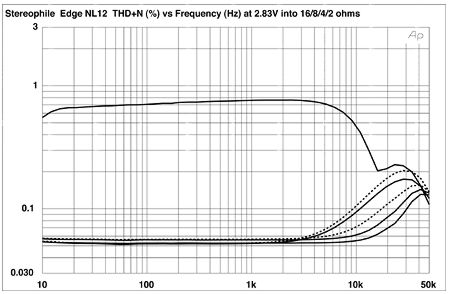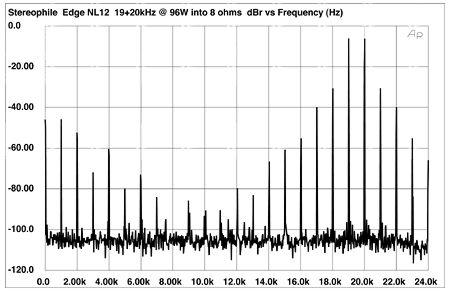| Columns Retired Columns & Blogs |
Edge NL-12 power amplifier Measurements
Sidebar 3: Measurements
As I always do before any testing, I ran the Edge NL-12 at one-third power into 8 ohms for an hour, in order to test the amplifier's ability to eliminate waste heat. Despite the relatively small profile of the NL-12's heatsinks, they had heated up to only 60 degreesC or so by the end of this period, proving they had adequate thermal capacity. However, the smell of hot insulation emanated from the amplifier's chassis. In addition, I monitored the amplifier's THD during the preconditioning period. It was surprisingly high at the outset, at 0.25% at 100W. However, instead of decreasing as the amplifier warmed up, it increased, reaching 0.28% after 30 minutes, and finishing at 0.29%.
The NL-12 preserved absolute polarity and offered a moderately high input impedance of 34k ohms. Its voltage gain was about 3dB higher than average, at 30.3dB. The amplifier's output impedance was 0.1 ohm over most of the audioband, rising to 0.3 ohm at 20kHz. (Both figures include the series impedance of 6' of speaker cable.) Any modification of its frequency response by the usual Ohm's Law interaction between the source impedance and the loudspeaker impedance will therefore be minor. The top dotted trace in fig.1, for example, shows that there was about ±0.2dB of response error with our simulated speaker load, which is minor. However, this graph also shows that there is some interaction between the amplifier's high-frequency bandwidth and the load impedance. While the -3dB point is a high 105kHz into 8 ohms, this drops to 43kHz into 2 ohms, with an audioband rolloff of almost 2dB at 20kHz.

Fig.1 Edge NL-12, frequency response at (from top to bottom at 2kHz): 2.83V into simulated loudspeaker load, 1W into 8 ohms, 2W into 4 ohms, 4W into 2 ohms (1dB/vertical div.).
Associated with the wide bandwidth into higher impedances, the NL-12's reproduction of a 10kHz squarewave (fig.2) showed short risetimes. However, there is a hint of overshoot on the waveform's leading edges. Given its apparently dual-mono construction, I was surprised to find that the Edge had some crosstalk, with more in the R-L direction than in the other. The L-R channel separation is excellent below 5kHz but merely good R-L (fig.3), though the latter should have no subjective consequences. The amplifier's A-weighted signal/noise ratio was excellent, at 90dB ref. 1W into 8 ohms. The wideband unweighted figure was only 64.5dB, due to the presence of some ultrasonic noise, as well as some 120Hz hum that I couldn't eliminate no matter how much I experimented with the grounding between the Edge and my Audio Precision System One. However, this hum is low enough in level that it won't be audible with non-horn loudspeakers.

Fig.2 Edge NL-12, small-signal 10kHz squarewave into 8 ohms.

Fig.3 Edge NL-12, channel separation (10dB/vertical div., R-L dashed).
Fig.4 plots the percentage of THD+noise in the NL-12's output against output power into resistive loads ranging from 2 to 16 ohms. Below 2W into any of these loads, the curves are conventional, their downward slopes indicating that the measured percentage is dominated by noise. Into each load, however, there comes an output power level where the distortion level suddenly rises. This rise is small in the case of a 16 ohm load (bottom trace) and takes place at 20W output, above which there is the usual "knee" at 116W. The clipping point (1% THD) occurs at 135W into 16 ohms (24.3dBW). Into 8 ohms, the initial rise in distortion is greater, reaching 0.38% between 40W and 50W, and the clipping occurs at 250W (24dBW), which is lower than the specified 300W (24.8dBW). The 4 ohm output reaches 1% in distortion at 20W, though the true clipping point occurs at 400W (23dBW). And the increase in distortion into 2 ohms (top trace) rises well above 1% even at powers of a few watts. Note that this trace ends at 450W, which is when the rear-panel 8A fuses blew.

Fig.4 Edge NL-12, distortion (%) vs 1kHz continuous output power into (from bottom to top at 10W): 16 ohms, 8 ohms, 4 ohms, 2 ohms.
To make sure that this was not specific to the left channel, which is shown in fig.4, I repeated the test into 8 ohms from the right channel. The top trace at low powers in fig.5 shows the left channel's behavior, the bottom trace the right channel's. The right channel is actually more linear than the left and reaches a slightly higher power before it reaches the point where its distortion starts to rise. However, both channels fundamentally behave the same, which effectively rules out the amplifier being broken as the cause of this behavior.

Fig.5 Edge NL-12, distortion (%) vs 1kHz continuous output power into 8 ohms from right channel (bottom at 1W), left channel (top).
If you look at the "break points" in the fig.4 traces, where the distortion percentage starts to rise, the output power where this happens halves each time the load is halved. This means that the break point happens at the same output current into each load, which a simple Ohm's Law calculation indicates is approximately 1A. At that current level (a little higher in the right channel), something is going wrong with the NL-12's operating parameters.
This radical change in behavior above or below the 1A output current limit can also be seen in the plot of small-signal THD+noise against frequency (fig.6). At 2.83V into 8 and 4 ohms, the THD+N percentage remains respectably low across most of the audioband, at just above 0.05%, with a modest rise in the top audio octave, where the distortion harmonics emerge from the noise floor. Into 2 ohms, however, where the current is greater than 1A, there is a disproportionate increase in distortion—except, puzzlingly, above the audioband.

Fig.6 Edge NL-12, THD+N (%) vs frequency (from bottom to top): 2.83V into 16 ohms, 8 ohms, 4 ohms, 2 ohms.
My next series of measurements examined the nature of the NL-12's left-channel distortion signature above and below the 1A output-current "tipping point." The lower trace in fig.7 was taken at 2.3W into 8 ohms. The distortion level was just 0.01%, and the harmonic content is heavily second-harmonic. Halving the load impedance and keeping the output voltage constant doubles the THD percentage, to a still low 0.02%. However—and this is an enormous "however"—the harmonic content changes from subjectively benign second harmonic to a spiky waveform loaded with potentially nasty-sounding higher harmonics (fig.8).

Fig.7 Edge NL-12, 1kHz waveform at 2.3W into 8 ohms (top), 0.01% THD+N; distortion and noise waveform with fundamental notched out (bottom, not to scale).

Fig.8 Edge NL-12, 1kHz waveform at 4.4W into 4 ohms (top), 0.02% THD+N; distortion and noise waveform with fundamental notched out (bottom, not to scale).
Given how coolly the NL-12 runs under normal operating conditions, I initially suspected drastic underbiasing of its output stage as the culprit for this behavior. However, if you look closely at fig.8, you'll see that the bursts of distortion coincide with the point in the waveform where the slope changes from positive to negative, not the zero-crossing points, where crossover distortion would be excited.
I have no idea what mechanism lies behind this idiosyncratic behavior. Without a circuit diagram it is impossible to diagnose what is going wrong, but perhaps the fault lies in the driver circuitry rather than the output stage. However, it means that, at high powers, the NL-12's output spectrum is corrupted by a veritable picket fence of distortion products. Into 8 ohms, the second and fourth harmonics are highest in level (fig.9), while dropping the load to 4 ohms brings up the third harmonic (fig.10).

Fig.9 Edge NL-12, spectrum of 50Hz sinewave, DC-1kHz, at 100W into 8 ohms (linear frequency scale).

Fig.10 Edge NL-12, spectrum of 50Hz sinewave, DC-1kHz, at 200W into 4 ohms (linear frequency scale).
Fig.11 shows the spectrum of the Edge amplifier's output driving a 1kHz tone at a very high level into 4 ohms. Again the harmonics are evident, and the 120Hz hum I mentioned earlier can also be seen, though this lies at a very low -96dB (0.0015%). More important, note the appearance of 120Hz- and 240Hz-spaced sidebands around not just the fundamental, but the harmonics as well. This suggests that either the NL-12 has suboptimal internal grounding or that the power supply is inadequately specified.

Fig.11 Edge NL-12, spectrum of 1kHz sinewave, DC-1kHz, at 200W into 4 ohms (linear frequency scale).
Finally, I measured the NL-12's susceptibility to high-frequency intermodulation at a level just below visible waveform clipping on the oscilloscope, 96W into 8 ohms. Many distortion components appear in the amplifier's output (fig.12), with the 1kHz difference component at an audible -43dB (0.7%). The level of the intermodulation components dropped slightly into higher impedances and as I reduced the level, but overall this behavior is evidence of poor high-frequency linearity on the part of the NL-12.

Fig.12 Edge NL-12, HF intermodulation spectrum, DC-24kHz, 19+20kHz at 96W into 8 ohms (linear frequency scale).
All in all, I was disappointed in the Edge NL-12's measured performance. Unless something was broken—and there were no obvious signs of this, both channels behaving identically—these measurements indicate an amplifier that has more in common with early transistor amplifiers than a modern design. Which begs the question: Why did Paul Bolin like its sound as much as he did?
PB did note that, out of the box, the NL-12 "sounded a little tight and unforgiving at first—the mids and top sounded rather dynamically constricted." This is what I would have expected from the measured performance. But I, too, listened to the Edge in PB's system, and while I preferred the sound of the Focal-JMlab Nova Utopia Bes driven by the McIntosh MC501 monoblocks (which Paul will review in the August issue), I wasn't driven screaming from the room. I imagine that this proves the adage about "the first watts being the most important," as Paul would not be asking the NL-12 to cross that demarcation line of 1A output current for much of the time. Below that point, the Edge does offer excellent measured performance; above it, the extra distortion on musical peaks will only last for the duration of the transient, which will work against audibility. Only on sustained high-level music will the Edge's sound become harsh.—John Atkinson
- Log in or register to post comments




































